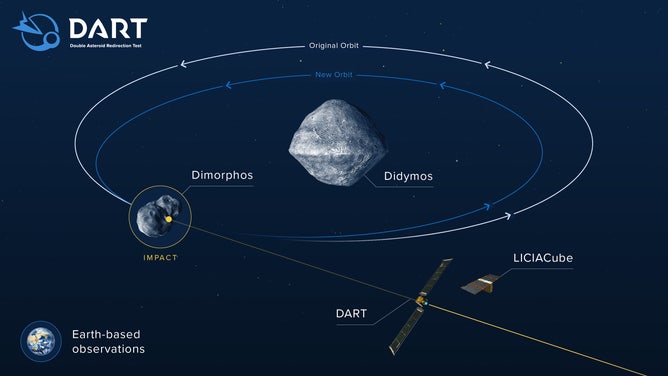NASA plans to test out Earth protection plan by crashing into an asteroid at 15,000 mph
DART spacecraft, launching in November, will test possible asteroid defense plan

Illustration of how DART's impact will alter the orbit of Dimorphos about Didymos. Telescopes on Earth will be able to measure the change in the orbit of Dimorphos to evaluate the effectiveness of the DART impact.
(NASA/JHUAPL)
An upcoming robotic NASA mission might sound like the plot of "Armageddon," but the purpose is to understand what would happen when Earthlings need to deflect an incoming asteroid.
NASA's Double Asteroid Redirection Test, or DART, spacecraft is set to launch from California on Nov. 24. The mission is among NASA's first to test out a planetary defense strategy.
DART is headed to an asteroid about the size of the National Monument named Didymos. There is a tiny moon orbiting the asteroid called Dimorphos, and that is what NASA plans to crash its spacecraft into.
Here's how NASA explains the mission objective: "The DART spacecraft will achieve the kinetic impact deflection by deliberately crashing itself into the moonlet at a speed of approximately 6.6 kilometers per second with the aid of an onboard camera (named DRACO) and sophisticated autonomous navigation software."
Translation: DART will slam into the asteroid at 15,000 mph and see if it can change the tiny asteroid's speed by a fraction of a percent. Even though the change will be minor, it will impact how quickly the moonlet orbits the asteroid.
If it works, researchers on Earth should be able to see the shift using telescopes. DART also has a little buddy in the form of an Italian Space Agency-built CubeSat that will be flying ahead to document any changes with the moonlet orbit.
Why do we need a planetary defense plan?
There are more than 20,000 near-Earth asteroids NASA is tracking. Near --in space terms-- is anything that comes with 30 million miles of Earth. Historically speaking, an asteroid has not caused a catastrophic event on Earth in 66 million years, but they do come close, and it could happen again, but not for hundreds of years.
Earth's current defense plan includes ground-based observatories and space telescopes like NASA's Near-Earth Object Wide-field Infrared Survey Explorer, or NEOWISE, tracking and identifying new asteroids. If a big one comes anywhere near Earth, astronomers will know about it long before it happens.
Neither Didymos nor Dimorphos poses a threat to Earth, but researchers chose the asteroids because their orbits fly close enough that NASA can observe the test from Earth.
DART is one part of an international collaboration to create a viable planetary defense game plan against an asteroid strike.
Mission timeline
A SpaceX Falcon 9 rocket will launch DART on Nov. 24 at 1:58 a.m. ET from Vandenberg Air Force Base in California sending it on a trajectory to catch up with Didymos and Dimorphous.
The spacecraft will catch up to the asteroid pair in September 2022 and complete the test soon after.